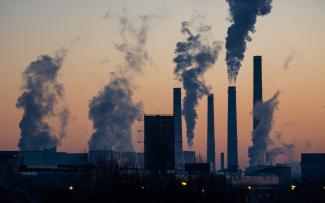Operationalizing Environmental Justice: The Justice40 Initiative
Shortly after taking office, President Joseph Biden released Executive Order No. 14008, Tackling the Climate Crisis at Home and Abroad. The Executive Order includes a new initiative, Justice40, which states that 40% of the overall benefits from specific federal investments—including energy efficiency, clean energy, clean water infrastructure, and training and workforce development—will be directed toward disadvantaged communities.
In a recent episode of People Places Planet Podcast, Gwen Keyes Fleming, a Partner at Van Ness Feldman whose practice focuses on environmental policy, and Mustafa Santiago Ali, Vice President of Environmental Justice, Climate, and Community Revitalization for the National Wildlife Federation, discuss the Justice40 initiative and the significance of a whole-of-government approach to environmental justice (EJ).
To illustrate environmental injustice in the United States, Ali highlighted examples from Cancer Alley, where residents breathe petrochemicals and suffer from the nation’s highest cancer rates, to gasoline fumes polluting the Manchester community in Houston, Texas, to Benton Harbor, Michigan, where water lead levels are higher than those during the Flint Water Crisis. Due to racism and discriminatory policy, such as redlining, among other structural causes, low-income communities of color disproportionally face high levels of pollution to air, water, and land. As environmental issues are suffered alongside housing and transportation injustices, as well as voter suppression, a holistic approach needs to be taken to provide redress to communities.
Fleming emphasized that everybody deserves a seat at the table when decisions about their health are made, yet that opportunity is usually denied to members of EJ communities. Ali explained that we must make sure EJ communities have real opportunities to engage and ensure the most vulnerable can frame out a new, more inclusive direction. Ali highlighted EJ is about basic human rights, the rights to breathe clean air and drink clean water.
Fleming indicated Justice40’s underpinnings in New York’s Climate Leadership and Community Protection Act, enacted in 2019. The Act, a historic climate law placing the state on a path to net-zero greenhouse gas emissions, requires New York to invest or direct 40% of resources to historically disadvantaged communities.
As Fleming described, the Interim Implementation Guidance document from the Office of Management and Budget provides a specific definition of “disadvantaged communities” based on 13 indicators. These indicators include income level, linguistic isolation, unemployment rates, impacts from climate change, and high-cost burdens from housing and transportation, going beyond traditional environmental indicators to encompass intersecting issues.
Ali explained that a holistic approach is required for transformational change. In the past, one government agency or department came into a community to do work, typically leaving behind a host of other challenges and opportunities. Under Ali’s leadership of the Interagency Working Group on Environmental Justice, he brought together several different federal agencies and departments to address community issues, creating transformative projects. By incorporating new indices for vulnerable communities, the Biden Administration is taking a holistic approach to EJ.
Fleming pointed to the ReGenesis Institute in South Carolina as a model to harness the new momentum from the federal government. Founded by Harold Mitchell, the organization leveraged a small EJ grant into billions of dollars of benefits by incorporating other federal agency partners, including the U.S. Department of Justice and the Department of Health and Human Services. As Ali described, the ReGenesis project prioritized community interests—access to affordable healthcare, housing, transportation, and jobs, as well as cleaning up brownfields and superfund sites. Ali pointed to other examples of success, including the work of Margaret May of the Ivanhoe Neighborhood Council in Kansas City, and Diane Takvorian and Carolina Martinez of Environmental Health Coalition in San Diego. These examples are not often cited yet provide dynamic models of how community-based work with collaborative partnerships can foster real change.

For communities that might not know where to start, Ali suggested EJ networks to learn about examples and priorities. The U.S. Environmental Protection Agency (EPA) is also an excellent resource, as the Agency offers training, including EJSCREEN training. The Council on Environmental Quality will also be sharing training to better understand steps. Many historically black colleges and universities and other institutions are helping communities learn how to utilize these tools.
Ali emphasized that more attention should be paid to the dollar side of the equation to ensure needed funds actually reach vulnerable communities. In addition, on the state level, work must be done to build capacity and accountability, particularly in states that have not taken steps to confront EJ or the climate crisis.
Fleming highlighted a major challenge is that vulnerable communities lack the capacity to go through the required auditing process or come up with matching funds for federal grants. The College/ Underserved Community Partnership Program (CUPP) helps fill these gaps; local colleges partner with federal agencies to provide technical assistance to underserved communities. Ali pointed to accelerator and incubator programs helping people prepare for new resources and opportunities. The legal profession and the accounting field can assist communities as well.
In considering accountability to ensure communities receive resources, Ali outlined several different approaches. From the EPA side, language can be built within performance partnership agreements between the Agency and states. Transparency is crucial, and the scorecard concept puts a spotlight on who is doing well and who needs improvement. Enforcement is also critical to ensure accountability.
In closing, Ali considered the meaning of “justice” to EJ communities and EJ advocates. The first part of “justice” is being able to address the needs of those who have been victimized and disproportionately impacted. The other part less talked about is being able to utilize—once impacts have been addressed—a new clean energy economy and other sets of opportunities to build jobs and wealth inside communities.
To learn more, listen to the episode, “Groundtruth: Operationalizing Environmental Justice,” of the People Places Planet Podcast, the official podcast of ELI. You can find recent episodes by visiting https://www.eli.org/podcasts or listening wherever you get your podcasts.
